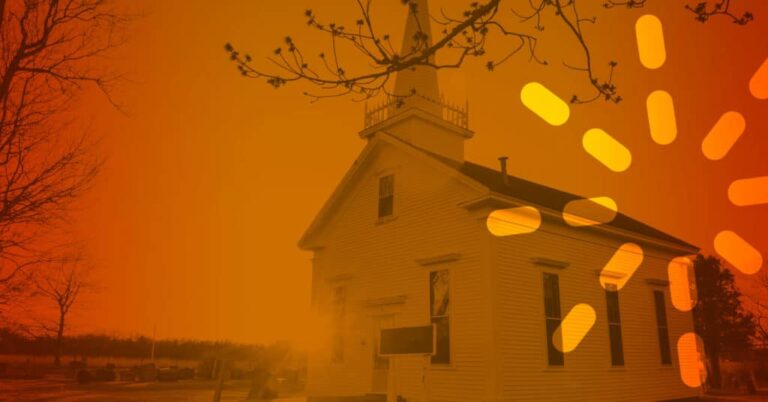Teaching the Lord’s Prayer for kids? Use this lesson outline to teach elementary students about the Lord’s Prayer and how Jesus used it as an example to point out the right and wrong ways to pray.
Editor’s Note: This lesson was adapted from Bible-in-Life, Upper Elementary.
SCRIPTURE: Matthew 6:5-13
FOUCS: Jesus taught us how to pray.
MEMORY VERSE: 1 Thessalonians 5:17
MATERIALS:
- Copies of Teaching Aid, Pencils, Whiteboard, Marker
- Bibles, Bible Adventures 1
- Bible Adventures 2
- Markers, Paper
- Bible Adventures 3
The Lord’s Prayer for Kids: Bible Background
Matthew records Jesus’ most familiar teaching on prayer in the midst of His criticizing the unspiritual practices of religious leaders (Matt. 6:5, 7, 16). For a different setting, see Luke 11:1-4.
Jesus’ words in Matthew 6:5-6 do not by any means condemn public prayer. Rather He speaks out against those who “grandstand” in prayer in an effort to impress others and to appear pious.
The pattern Jesus set forth begins with praise to God as Father. Jesus’ use of the more intimate word Abba (Papa) was a radically personal approach to God in a religious culture that often avoided even mentioning God’s name!
Jewish teaching saw sins as “debts” before God, and indeed, in Aramaic, the common language of Jesus’ day, the same word could mean both debts and sins.
There are three basic elements to the Lord’s Prayer: adoration, petition, and confession. The opening section of the prayer honors God’s name, recognizes His holiness, and submits us to His will. The petition for “daily bread” that follows suggests that we need to bring our needs daily before God in prayer—seeking God’s provision for needs to be met as they arise. And finally, the confession asks for forgiveness “as we also have forgiven.”
The last part of the familiar prayer, “For thine is the kingdom . . .” (KJV) is missing from the NIV text, because it was not included in the earliest and most reliable New Testament manuscripts.
The Lord’s Prayer for Kids: Early Bird Activity Options
Here are some suggested activities you can set up to occupy students who arrive early. Both activities will help your students begin thinking about Jesus’ example of how to pray.
Picture Prayers—On a large piece of paper, have students draw pictures to represent prayer requests, either theirs or those of family and friends.
School of Prayer—Have students write out instructions for someone who has never prayed before. They should tell what prayer is and how they pray.
Connecting with God’s Word
To help them connect with the Bible study on prayer, students will compare and discuss their prayer experiences and attitudes.
Materials:
- Copies of Teaching Aid
- Pencils
- Whiteboard
- Marker
In today’s lesson from Matthew 6:5-13 your students will be introduced to Jesus’ teaching on how to pray. To help your students bring their own experiences to the lesson so they have a starting point of connecting to the lesson, lead them in this “Prayer Survey” activity that follows.
Before class, you will need to make photocopies of the “Prayer Poll” (Teaching Aid)—enough so that each student has one.
Tell students you are going to take a poll or survey on prayer. Distribute copies of the Teaching Aid, “Prayer Poll.” Encourage students to be honest. They can check more than one answer if needed. Using one of the copies, read through all the questions, pausing between each one for students to mark their answers.
After students fill out the survey, do a quick tally by having students raise their hands for each choice. Write down the most popular response to each question.
Encourage them to discuss the reasons they responded as they did, being open to all reasons. You may want to emphasize that there are no right/wrong answers. After a few minutes, begin to make the transition into the Bible study by asking:
- What is the best way to pray? (Allow students to answer freely. Their answers will help you understand their attitudes and beliefs about prayer as you go into the Bible study section.)
Move into the Bible study time by saying something along these lines:
SAY: There are many times, places, ways, and reasons to pray. In today’s Bible study, we’ll see how Jesus’ disciples wanted to learn how to pray. Let’s see what His answer was.
Studying God’s Word
Using the Bible and Bible Adventures, students will explore Matthew 6:5-13 in which Jesus teaches the disciples to pray.
Materials:
- Bibles
- Bible Adventures 1
Distribute copies of the Bible Adventures 1. Direct students to find Matthew 6:5-13 in their Bibles.
SAY:
Jesus’ disciples spent a great deal of time with Jesus, listening to His teachings. Today we’re going to find out what Jesus taught them about prayer.
Read aloud the introductory paragraph of the Bible Adventures 1 (or have a student read it), which is reprinted here: Jesus taught a large group of people who were gathered on a mountain. He taught them many things, including prayer. He told His listeners not to make a big show of their praying.

Then have a volunteer read Matthew 6:5 aloud to the class.
ASK:
- What did Jesus say about people who pretend to be holy when they pray? (They want to be seen by others. They have already received their complete reward.)
- What reward does Jesus mean? (Allow students to speculate. Direct them to see that the “recognition” they received was all they reward they would get.)
Turn student’s attention to the Scripture Spotlight (Matthew 6:6-13). Ask two students to read the first section for the class (breaking at “… will reward you” and the second student starting at “And when you pray,…”)
ASK:
- What things did Jesus say to do and not to do when you pray? Why? Write down students’ answers on the board. (We should pray privately to God. We should not pray talking on and on without meaning it. We should honor God and ask Him for what we need and for forgiveness. God sees what we do in secret and knows what we need even before we ask.)
Ask a third student to read the next paragraph. (“This, then…”) aloud as others follow along. Take a moment for students to read the footnotes to themselves.
ASK:
- Why do you think it’s important that the prayer begins with praise for God? (Allow for responses.)
- What do we ask to be done on this earth and in heaven? (God’s will; what God wants done.)
Have students read the next paragraph (“Give us today…”) in unison. Allow a moment to read the footnote. The second question in this section is not found in Bible Adventures but is included here to extend your students’ understanding on the lesson.
ASK:
- What does “daily bread” mean here? (Help students see that the term goes far beyond just bread, or even food. It includes all things we need.)
- What do the words debt and debtors mean the way they are used here? (Allow students to speculate freely. If they are familiar with the word, it may be in the context of finances. Debts here mean our sins or wrongdoings; debtors are those who sin or do wrong to us.)
- How do we ask God to forgive us? (Allow for responses. We pray to ask God’s forgiveness. Help students make the connection between God’s forgiveness and their own—God forgives our sins and expects us to forgive those who sin against us as well.)
- Who is the evil one? (Satan; the devil.)
- What will he try to do? (Tempt us to do wrong, to turn from God’s ways.)
Ask a student to read the final paragraph aloud as the others follow along, and then have another student go back to Matthew 6:11 and read it from the Bible.
ASK:
- What are some of life’s daily needs that we take for granted? If God gives us these things whether we ask for them or not, why do we have to pray for our daily needs? (We might easily take for granted such things as food, shelter, clothes, water, and family. Praying for these needs reminds us that God is the giver of life. Prayer helps us remember to depend on God for our needs, both great and small.)
- If God wants us to live for Him, why does He let temptation fall in our path? (Facing temptations helps build faith. We learn to depend on God to help us resist temptation. Like our petitions for food, our prayer for help with temptation reminds us that we need God’s strength to resist temptation.)
- What can we learn about prayer from Jesus’ example? (Some possible answers: We should praise God for being great and for all He does for us; we can ask God to help us with all out needs; we can ask God for forgiveness and help in forgiving others; and we can pray that God’s will be done here on earth.)
When the discussion is finished, move on to the Memory Verse Practice.
Memory Verse Practice
Pray continually.
1 Thessalonians 5: 17
Divide the class into two groups. Have each group take one word of this short verse and one part of the reference (“1 Thessalonians” and “5:17”). Have the groups say the words in order followed by the reference. Encourage them to say it slowly at first, then speed it up. Then switch groups as time allows.
Interacting with God’s Word
Students will practice the lesson from Matthew 6:5-13 by exploring what it means to follow Jesus’ teaching on prayer.
Set up the learning activities in different parts of the room, and give students the choice of activities they prefer. Use as many of the activities as possible so all your students will have activities they enjoy.
The Lord’s Prayer for Kids Activity 1: Prayer Pointers
Materials:
- Bible Adventures 2
- Pencils
To help your students see how praying as Jesus taught works out in practical ways, let your students work through the worksheet “Prayer Pointers” (Bible Adventures 2). Students will see how the Lord’s Prayer can help them in everyday situations by showing them how to pray for problems they might encounter.
ASK:
- How can these verses help you know how to pray in different situations?
The Lord’s Prayer for Kids Activity 2: Lord’s Prayer Interpretation
Materials:
- Bible Adventures 1
- Bible
- Pencils
- Markers
- Paper
To help your students personalize and gain a deeper understanding of the Lord’s Prayer, let them explore the prayer with this meaningful activity. Students should imagine they are teaching someone who speaks a different language about the Lord’s Prayer. Let them interpret the prayer in drawings or symbols. Each student could work on one section of the prayer. As an option, students may prefer to communicate the meaning of the prayer in movement, using their hands, faces, and bodies. If time allows, encourage them to present their interpretations to the rest of the class.

ASK:
- How could you share Jesus’ teachings with another person?
When the time you have allotted is up, ask your students to clean up the materials and gather back together.
Applying God’s Word
To help them apply the lesson to their lives, students will plan times this week to follow Jesus’ instructions on prayer by praying parts of the Lord’s Prayer.
Materials:
- Bible Adventures 3
- Pencils
- Bibles
After you have given time for cleanup and gathered your students from their various activity choices.
SAY: Today’s memory verse tells us to “pray continually.” In Matthew 6:5-13, Jesus teaches how to pray.
Pass out Bible Adventures 3 to each student. Point out the way the circle is set up—moving clockwise through the verses that make up the Lord’s Prayer. Using the Bible, have your students work as a group to match each verse with the parts of the Lord’s Prayer.
Move into a contemplative time. Have your students find a quiet place within the classroom. Allow time for them to fill in at least two or three sections of the wheel; either paraphrasing the Bible verse or writing their own prayer that matches the “topic” of the Bible verse in that section.
If more time is needed, challenge your students to finish filling in the rest of the circle for themselves during the week. Encourage them to use their prayer circle throughout the week as well as other prayers.
For a closing prayer, read Matthew 6:9-13 aloud. Pause after each verse and allow time for students to pray about that Scripture section silently.
Seeing God Throughout the Week:
Encourage students to follow the pattern of the Lord’s Prayer during their prayer time this week. Remind them that God hears their prayers and desires this communication with them. Challenge students to pray continually.
Need more lesson ideas? Try these:
- How to Make Sure your Bible Lessons Make a Difference in Kids’ Lives
- How to Teach Kids the Creation Story
- The Ten Commandments for Kids
- The Fruit of the Spirit for Kids
Did you enjoy this lesson? It was adapted from Bible-in-Life, Upper Elementary. To learn more about this curriculum, check out the video below or visit BibleinLife.com.
Explore every age level at BibleinLife.com!







